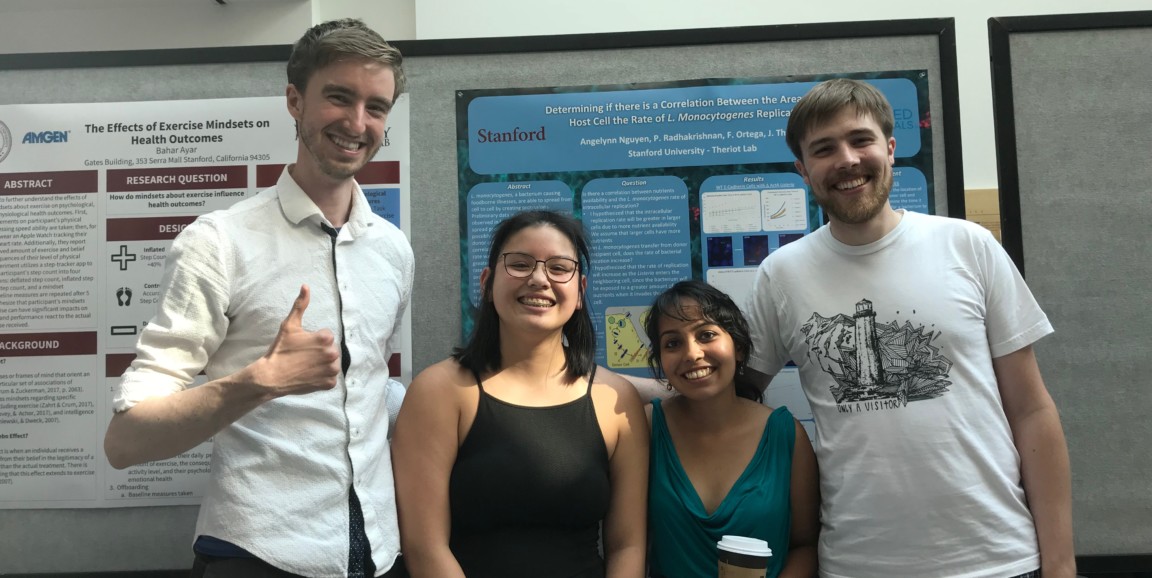When Cooper Galvin came to Stanford in 2014 to earn a PhD in biophysics, he intended to work toward winning a Nobel Prize, or at least curing tuberculosis.
"It hasn't really happened that way," Galvin admitted. Instead, perhaps just as spectacularly, he — along with a group of other Stanford graduate students — has spearheaded the creation of FAST, which stands for Future Advancers of Science and Technology.
It started small, rooted in a conviction that disadvantaged groups shouldn't be underrepresented in STEM fields.
"We take this classically liberal view of scientific thought and engineering that it's an expression of the human spirit and something that truly anybody should be able to engage in," Galvin said.
Galvin and a few of his graduate student friends — including Andrew Kennard, Athena Ierokomos, Carlos Hernández and Derek Huang, all graduate students in biophysics — relied on what they knew: that they all could point to an experience that had ignited their passion for academics and science, an experience powerful enough to propel them to Stanford.
Oftentimes, that experience had been sparked by a charismatic teacher, or by someone just willing to encourage them to explore and experiment.
That experience, they believed, should be available to everyone, including those from disadvantaged communities. To put their ideas into action, the graduate students set their sights on Andrew P. Hill, a high school in east San Jose where 70 percent of students are lower income. More than half of its students identify as Hispanic and about 35 percent are Asian; many are immigrants or the children of immigrants from Vietnam.
Galvin picked a few Andrew Hill science teachers who had received good reviews online and connected with Patrick Allamandola, an experienced physics and chemistry teacher known to be tough but well-liked.
Galvin and Allamandola met for coffee and found they had quite a bit to talk about; their initial meeting lasted for more than two hours.
Galvin shared the graduate students' nascent idea: First, pair up high school students with Stanford mentors. Then, allow the high schoolers the opportunity to explore a question that piques their curiosity. The final product would be an independent investigation, one that could fulfill a school requirement for the International Baccalaureate Program and also be showcased at area, or even state, science fairs.
Allamandola was interested, but skeptical. The Stanford volunteers might "try to save the world, get discouraged, and leave," as Galvin describes. Allamandola also had doubts about the high school students. Some must sleep on couches just to attend school; others struggle to secure food. Would the right space and support make them passionate, excited and curious?
But Galvin was confident. "You could call it a belief, but I also just knew it would work, because I'd seen it work for so many students," Galvin said.
And so they agreed to give it a shot, deciding that the program would run every other Saturday afternoon for a total of 13 or so sessions per school year. The Stanford students would also plan to bring food — healthy, creativity-fueling food — to begin each meeting.
Allamandola knew the luster of the Stanford name would get some Andrew Hill students to attend. "And the mentors' passion will keep them coming," he said. "They picked up that there was enough realness, enough authenticity from the Stanford students to keep the kids coming."
Despite challenges, such as convincing busy Stanford graduate students to make a long-term commitment to a program that was, at this stage, just an idea, FAST began in the fall of 2015, with the help of the Andrew Hill principal and other science teachers. It had a handful of mentors and not all that many high school students.
The first year had a few hiccups, but the team knew their formula was sound.
"We stumbled onto something that is what we would all want out of an educational experience — the ability to follow something that we are curious about and to be encouraged by peers and encouraged by mentors to turn it into something really cool that our students are proud of," Galvin said.
One reason FAST clicked, co-founder Kennard explained, is that it followed the tenets of design thinking and the grad students tailored their approach to the needs of the Andrew Hill community. "Everything about it is such a reciprocal process," Kennard said. "A huge part of the success of FAST is that we iterate and really listen to what we can do to be helpful."
Fast-forward to 2018. Now, FAST has expanded to a second San Jose school, James Lick High School. It has over 100 high school students and 70 or so Stanford graduate student mentors, the program's leaders estimate. And last year, 100 percent of FAST graduating seniors went on to attend college.
The program has, literally, changed lives.
This is the first installment of a four-part series on FAST.
Photo of, from left, Cooper Galvin; third-year FAST student Angelynn Nguyen; former Stanford biophysics graduate student and mentor Prathima Radhakrishnan; and Andrew Kennard courtesy of Cooper Galvin




